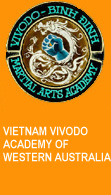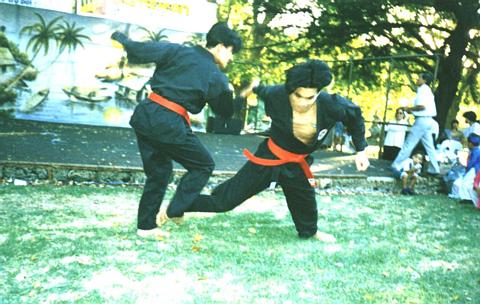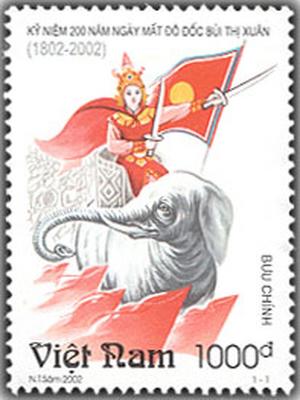
![]()
VIVO DO is Vietnam's
traditional martial arts, practice for good health and self - defence. VIVO-DO
means the way of Binh Dinh Fighting Arts. Vi is Vijaya (Emperor citadel in Binh Dinh)
defence. VIVO-DO
means the way of Binh Dinh Fighting Arts. Vi is Vijaya (Emperor citadel in Binh Dinh)
ViVo Do was originally developed in central Vietnam in the 18th century as
vo (fighting arts) from Tay Son Binh-Dinh, home of Vietnam's martial spirit.
When a senior group of leading martial arts experts in Binh Dinh were
captured to Concentration camps after the fall of Saigon in April 1975, or
too old ages were passed away.
Master Thanh Tong came together with master Vo Thai Hung who was born in
An-Thai village and learning many styles in Binh Dinh to unify their
respective disciplines under a single fighting system called "Vivodo
(Bach Long Chien Dao
style)".
However, its root stretch
back nearly 2000 years, when its born from an art known
 as vo thuat meaning
"hand-to-hand combat arts" in the Trung vuong
dynasty, in about 40-43 AD to develop a fighting system to protect their
kingdom against invasions.
as vo thuat meaning
"hand-to-hand combat arts" in the Trung vuong
dynasty, in about 40-43 AD to develop a fighting system to protect their
kingdom against invasions.
In the Ly dynasty, the Dai Viet army consisted of ground and marine troops.
Among the ground troops, besides the infantry serving as the core, there
were also cavalry, elephant, and crossbow forces, etc. Naval force had big
boats and good skills for naval battle. In the capital, there were bases for
training the art of warfare and martial arts.

In the Ly dynasty, the irregular troops (ngoai binh) were not provided with
food rations, their services in the army were rendered in turn. At the end
of their services, they returned home to do farm work for self-supply. The
Tran followed the Ly, troops in the army were sent home in turn to do
farming with a view to reducing the volume of food demand. The way to supply
the army in the Early Le was in the main identical to the 'peasant -
soldier' policy in the Ly and Tran dynasties which helped reduce the demand
of food to the army." This policy with the focus laid on the combination of
"army and farming" was a military mechanism applied in the realities of
society until the 15th century.
Vietnam passed through a series of dynasties, and its name was changed
several times. Each dynasty is famous for its own accomplishments. The Ly
dynasty is famous for the general Ly Thuong Kiet, the Tran dynasty had king
Tran Hung Dao,...

Vietnamese warrior brandishing a spear:
Note the dragon symbol on the shield as well as
the tattoo on both thighs
(painted imprint on an earthen pot from the Tran dynasty).
Toward in a late 18th century, the martial arts school in Binh Dinh had
taught as a large vo Binh Dinh for people and soldiers to protect the
country from the strong neighbor invasions. During the Tay Son period, Binh
Dinh martial arts turned to a new stage in response to the demands of the
insurrection.
 The Tay Son insurrection created an environment that forced Binh Dinh martial arts to increase its quality. Binh Dinh has been an
important training ground for its followers for over a century. Legend, folk
songs, documents and scholars have all recorded Binh Dinh's role as the
nation's premier location for martial arts devotees. According to Quach Tan,
a scholar and author of The Mountains and Rivers of Binh Dinh, an old folk
song provides many clues to the emergence of Binh Dinh martial arts.
The Tay Son insurrection created an environment that forced Binh Dinh martial arts to increase its quality. Binh Dinh has been an
important training ground for its followers for over a century. Legend, folk
songs, documents and scholars have all recorded Binh Dinh's role as the
nation's premier location for martial arts devotees. According to Quach Tan,
a scholar and author of The Mountains and Rivers of Binh Dinh, an old folk
song provides many clues to the emergence of Binh Dinh martial arts.
The Tay Son were savage fighters and
initially successful beyond any expectations. Part of the explanation for
their battlefield successes was vo Tay Son, often known as vo Binh Dinh.
Vo BINH DINH practised for good health, sound mind in sound body and self-defense, which contributed to Vietnam's establishment through Viet history of fighting for self-survive and development of Vietnamese. The Vo Binh Dinh Spirit of freedom instills strong martial arts training into Vietnamese culture, like an arrow into the heart. The shaft of this arrow of national honor is service to the community and its tip is love for one's fellow citizens.
 With
particular characters and the best of Traditional Martial Arts in Binh Dinh
or Vo Tay-Son Vietnamese history for thousand years have developed and
improved through fighting foreign invaders and tyrants.
With
particular characters and the best of Traditional Martial Arts in Binh Dinh
or Vo Tay-Son Vietnamese history for thousand years have developed and
improved through fighting foreign invaders and tyrants.
Vo Binh Dinh stills spiritual martial arts, training strong will, advance spirit, love people and serve to Community.
Vo Binh Dinh has three main styles as AN-THAI, THUAN-TRUYEN and AN-VINH. An-Thai, An-Vinh styles were very famous empty-hand forms and Thuan-Truyen style was very famous weapons forms in Binh Dinh. Some extended techniques included 18 different weapons forms. The best weapon forms in Binh Dinh are Staffs, Swords, Sabers and Spears (Con, Kiem, Dao, and Thuong).
Tay Son Fighting arts has its roots in a late 18th century peasants' revolt in Vietnam. The political situation in Vietnam at that time was very complicated, with two ancient families, the Nguyen and the Trinh, contesting for control over the Vietnamese throne. In the Tay Son region, with today's Binh Dinh province at its heart, three brothers of another Nguyen family, Nguyen Nhac, Nguyen Lu and Nguyen Hue, ignited a revolt of oppressed peasants in 1773.
Each of the three brothers (as well, apparently as other generals also of the Nguyen family) contributed to today's Tay Son fighting arts and practitioners in the tradition trace their lineages to one of them, known as vo Binh Dinh.
There are many Binh Dinh schools or styles in Vietnam as VO TAY SON, TAY SON VO DAO, VO TRAN TAY SON, BACH LONG TAY SON, TAY SON BINH DINH, VO BINH DINH, BA TRA TAN KHANH, VO TRAN BINH DINH, BACH LONG CHIEN DAO, XICH LONG TAY SON, KIM SON BINH DINH, VO CHIEN TAY SON, VO THUAN TRUYEN, VO AN THAI, VO AN VINH, VO CO TRUYEN BINH DINH, VO TA, VO THUAT BINH DINH, and PHAN THO school (vo duong), HA TRONG SON school in Tuy Phuoc, PHI LONG school in Tay Son, BINH SON (Binh Dinh-Tay Son) school in An Thai, Ho family Style (vo phai), Dinh family Style ... In 1972, the Vo Thuat Binh Dinh Association had established with complete tradition Styles of Binh-Dinh.
 The Dong Da festival is an annual celebration held from 1960, at Tam
Kiet Tay Son temple in Kien My village (old Tay Son), Binh Phu commune, Binh
Khe district (now Tay Son district) on the 5th lunar day of the Tet New
Year. That is a great traditional festival in Binh Dinh province.
The Dong Da festival is an annual celebration held from 1960, at Tam
Kiet Tay Son temple in Kien My village (old Tay Son), Binh Phu commune, Binh
Khe district (now Tay Son district) on the 5th lunar day of the Tet New
Year. That is a great traditional festival in Binh Dinh province.
Many martial arts were created during XVI-XVIII centuries, when Vietnam was separated in several states. It was a good situation for the developing of martial arts. Many martial arts surfaced during the Tay Son Rebellion (1771-1788), the first serious attempt for unifying the country. The rebel's base was in Binh Dinh Province, which still is a place with many martial arts.
The country was finally united at the beginning of XIX century. But during the period of 1858-1884 Vietnam was conquered by France and became its colony. During the colonisation martial arts had kept underground and were transferred in family school only, from father to son, actually Buddhist monks kept it alive as well. Studying was kept secret, students sweared to never use their martial art without serious reason and to not divulge its secrets.
Since the XI century there was an academy (or university) of martial arts in the capital, Thang Long city (today's Hanoi). This academy prepared master-teachers, who had a diploma of "doctor of military science". Every candidate had to pass 11 exams, and then he studied for 3-5 years until passing the graduate exam. This time also is known for its variety of competitions, and for the creation of numerous treatises on martial arts as "Luc tuong tang vuong pho minh binh thu chieu phap" with the forms are U linh thuong, Tru hon kiem (Ly dynasty); Chan loi am tien, Loi long dao (Tran dynasty) ...
In 1789, the 2nd year of king Quang Trung the court had organised the martial arts exam at Phu Xuan capital (now Hue), Le Si Hoang candidate was excellent skills of Dai Dao with honour awards of king Quang Trung.
In 1867, king Tu Duc's court was established the martial arts school in Binh Dinh for exams to choose bachelor of vo (vo Cu) and Tao Si PhD's martial arts.
Also in the late Nguyen dynasty, Mr Nguyen Dinh Trong alias "cu Ton", passed bachelor of martial art in 1878 (Mau Dan) as his rank was Suat Đoi from 1881, and later become highest rank as August and Supreme Marshal of the Army of the Court of Hue in 1943 (Nguyen Soai Đai Tuong Quan Thong Che duoi trieu dinh Hue năm 1943, năm Bao Đai thu 18), when Mr cu Ton was retired and taught traditional Vietnamese martial art to his young generation and students in decade 40 at Hanoi, the examinations were the famous forms of traditional Vietnamese martial art as Ngoc Tran, Ngu Mon Con, Lao Mai, v.v...
In his own courtyard in Văn-tan Hamlet he (Cu Ton) had trained large numbers of young men how to punch, kick and stab ... Following the family tradition, on the large central patio of naked clay at the 13 Cite' Văn-tan address, I myself learned , at the age of ten, the (beginners') pugilistic dance called "Jade Cup" (quyen Ngoc-tran) and the "Five-Gate Long Stick" (con Ngu-mon) , of which I do remember only the principal postures and movements. All component forms (jumps, leaps, punches, kicks, and so forth) of every lesson in a typewritten booklet with their respective fancy names, particularly of the difficult and lengthy "Old Plum Tree" routine (quyen Lão-mai) that artfully combined grace and power.
Mr Nguyen Da had passed
Bachelor of martial art in Binh Dinh School in 1867, he left Binh Dinh
to go to West-Southern Mountains of Vietnam and choosed
the Forbidden Mountain (Nui Cam) was the Headquarters for training Vo nghe
Binh Dinh for his disciples and teachings Path in many provinces in South
Vietnam. Mr Nguyen Da alias "Ngoc Thanh Chan Nhan".
Following in 1980, master Thanh Tong took a risk by boat escaped to Thailand
in refugee camps, and came to Perth WA in early 1982 and later to open the
WA Vietnam Vivodo Academy for teaching Vivodo Binh-Dinh martial arts.
VO BINH DINH is a style that originated in Binh Dinh Province. It is based on the assumption that the opponent is non-Vietnamese and therefore likely taller and heavier. Hence a Vo Binh Dinh fighter constantly moves, changes positions, changes the directions of movement, uses counter-strikes to attacking arm or leg.
The "Vietnam VIVODO Academy of Western Australia" founded by master Tong Huynh teaching Vietnamese Martial Arts (Binh-Dinh traditional martial arts and Vivodo fighting arts) from January 1983 in Perth WA.
Besides pure Vietnamese styles, there are also numerous Sino-vietnamese styles (e.g. Thieu Lam, Bach My Phai). Those schools were popular among Chinese, who lived in Vietnam. Also more recently, after the creation of People's Republic of China, some masters immigrated to Vietnam including the following styles: Mei Hoa (Meihuaquan), Vin Tsun (Yongchunquan, also known as Wing Chun), etc.
[ VIVODO Homepage ] [Introduction] [ Philosophy ] [ Techniques ] [ Appendix ]